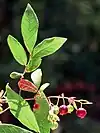| Vaccinium stamineum | |
|---|---|
 | |
| Scientific classification | |
| Kingdom: | Plantae |
| Clade: | Tracheophytes |
| Clade: | Angiosperms |
| Clade: | Eudicots |
| Clade: | Asterids |
| Order: | Ericales |
| Family: | Ericaceae |
| Genus: | Vaccinium |
| Species: | V. stamineum |
| Binomial name | |
| Vaccinium stamineum L. 1753 | |
| Synonyms[2] | |
|
Synonymy
| |
Vaccinium stamineum, commonly known as deerberry, tall deerberry, highbush huckleberry, buckberry, and southern gooseberry, is a species of flowering plant in the heath family.[3] It is native to North America, including Ontario, the eastern and central United States, and parts of Mexico.[4][5] It is most common in the southeastern United States.[3]
Description
This species is quite variable in morphology.[6] It is a shrub usually growing up to 1.5 meters (60 inches or 5 feet) tall, but reaching up to 3 meters (10 feet) at times. It has multiple twisted trunks covered in peeling reddish bark and is highly branched, tapering into thin twigs, some just a millimeter wide. It is deciduous, with alternately arranged leaves. The thin leaf blades are yellow-green, sometimes hairy or waxy in texture, especially on the undersides, and oval in shape with pointed tips and smooth edges. They are up to 7 centimeters (2.8 inches) long by 2.5 cm (1 inch) wide. The flowers are borne in hanging inflorescences from the leaf axils. Each flower has five green sepals and a bell-shaped corolla of five fused white petals about half a centimeter (0.2 inches) long. The long, yellow stamens protrude, bearing long, tubular anthers. The style is longer than the stamens. The fruit is a spherical berry about a centimeter wide. It is greenish or yellowish, often with a purple tinge.[3][2]
 fruits
fruits habit
habit
Biology and ecology
This plant usually grows in dry, rocky habitat types in forests and fields, but it sometimes occurs in moist areas such as bogs and swamps. It grows in acidic, well-drained soils. It is wildfire-adapted and associated with fire-tolerant vegetation.[3]
It establishes via seed, and commonly spreads via woody rhizomes, with a single plant forming what appears to be a thicket with many trunks. Because most of the mass of the plant is underground, it easily survives fire and the above-ground parts grow back.[3]
The fruits are large for a Vaccinium species. They are an important food source for many kinds of wildlife. They are eagerly consumed by deer along with the twigs and foliage, the inspiration for the common names deerberry and buckberry. Smaller animals gather fallen fruits from the ground. They are food for many songbirds, ruffed grouse, bobwhite quail, wild turkey, foxes, raccoons, black bears, chipmunks, and squirrels.[3]
The plant is pollinated by bees, the primary pollinator being Melitta americana. Bees dislodge, accumulate, and disperse pollen with buzz pollination while foraging nectar from the bell-shaped flowers.[6] This species is a host to the blueberry maggot (Rhagoletis mendax) a pest of blueberry crops.[3]
Uses
The fruit is edible for humans, and the taste has been described as tart, sour, bitter, or "sweet-spicy tasting, a little reminiscent of lady's perfume".[3] It has long been collected in the southern United States for preserves and pie filling.[7] Deerberries contain potent free radical scavenging activities.[8] However, deerberry is of the Vaccinium genus, which typically contains high amounts of oxalates.[9]
References
- ↑ "Vaccinium stamineum". NatureServe Explorer. NatureServe. Retrieved 2018-09-23.
- 1 2 Flora of North America, Vaccinium stamineum Linnaeus, 1753. Deerberry, southern gooseberry
- 1 2 3 4 5 6 7 8 Hill, S. R. Conservation Assessment for Deerberry (Vaccinium stamineum). United States Department of Agriculture, National Forest Service, Eastern Region. December 31, 2002.
- ↑ "Vaccinium stamineum". Germplasm Resources Information Network. Agricultural Research Service, United States Department of Agriculture. Retrieved 10 January 2018.
- ↑ Biota of North America Program 2014 county distribution map
- 1 2 Cane, J. H., et al. (1985). Pollination ecology of Vaccinium stamineum (Ericaceae: Vaccinioideae). American Journal of Botany 72(1), 135-42.
- ↑ Ballington, J. R. (1996). The Deerberry (Vaccinium stamineum L. Vaccinium Section Polycodium (Raf.) Sleumer) a potential new small fruit crop. Journal of Small Fruit & Viticulture 3(2-3), 21-28.
- ↑ Wang SY, Feng R, Bowman L, Lu Y, Ballington JR, Ding M. Antioxidant activity of Vaccinium stamineum: exhibition of anticancer capability in human lung and leukemia cells. Planta Med. 2007 May;73(5):451-60. doi: 10.1055/s-2007-967164. Epub 2007 Mar 29. PMID: 17394101.
- ↑ Cranberry. Drugs.com. Retrieved on 6 Mar. 2023. "Controversy exists over cranberry as a risk factor for the formation of calcium oxalate kidney stones, and the use of cranberry products in individuals with a history of nephrolithiasis probably should be avoided. A small study observed that consumption of 1 L/day of cranberry juice significantly increases the relative saturation ratio of calcium oxalate compared to drinking water similarly for subjects with and without a medical history of calcium oxalate stone formation...The genus Vaccinium also includes the blueberry (Vaccinium angustifolium Ait.), deerberry (Vaccinium stamineum L.)..."
